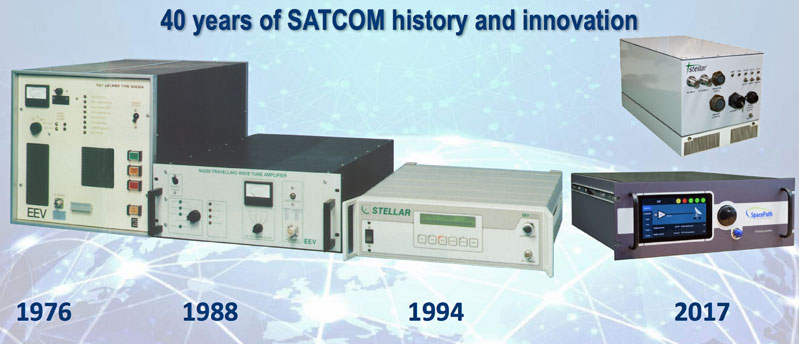SatMagazine Article by Newton Burnet - September 2017

The Evolution Of Uplink Amplifier Technology - A Spacepath Perspective
by Newton Burnet, Chief Technical Officer and Co-Founder, Spacepath
To quote a slogan that has been effectively adopted by the UK Export Trade body, “Technology is great.”
Telecommunications play a significant role in social and political relationships as well as in the economic growth of nations. The rate of technology change is exponential — the human desire to distribute and consume information increases proportionally with the technology that enables services at affordable prices. The world’s desire continues to grow for information and entertainment content delivery.
The SATCOM industry provides essential industrial infrastructure to feed the need for global data consumption. The demand for greater bandwidth and lower cost services has fueled significant changes in technology for the SATCOM industry. The industry has innovated and improved on the efficiency of modulation and coding of information. That has resulted in higher density and greater bandwidth RF signals for transmission via SATCOM systems. The industry has also improved the capacity efficiency of satellites, flooding the market with available bandwidth and driving the need for greater power and bandwidth transmitters within the SATCOM network. The SATCOM high power amplifier market has also significantly evolved over the last three decades, with the appetite for increased transmitted power, bandwidth and efficiency driving this service expansion.
Indoor klystron and traveling wave tube (TWT) based amplifiers fulfilled the need for SATCOM systems in the 1980s. The application of TWT amplifiers in outdoor formats significantly changed the landscape of SATCOM systems in the 1990s.
The growth of technology in GaS and GaN devices made significant impacts in the market in the 2000s. Early devices had clear limitations with respect to frequency and power. Higher power solid state amplifiers were designed by banking up multiple power modules, meeting the overall output power specifications, but these amplifier designs were big and very inefficient compared to TWT technology.
Solid state amplifier product appeal on the outset looks far more sexy than TWT technology and, unless further investigation into the performance and specifications of that technology, users may not change their minds. The real truth is that there is room for both technologies in today’s SATCOM market — the selection of which technology to select will depend on power, frequency, size and efficiency decisions.
The klystron power amplifiers (KPA) were robust high power solutions for SATCOM up-linking systems in the 1980s and the 1990s. The devices achieved high powers with multiple channel narrow band tuning of 40 to 80 MHz. These amplifiers served the purpose of powering complex, multiplexed, combined systems, which required the high power of a klystron to overcome the system losses.
In the late 1990s, the klystron witnessed an evolutionary change as size was decreased by 50 percent with the application of operation and power control technology. The introduction of the one-half height KPA made a market impact thanks to significant improvements in operational expenses such as power consumption and HVAC demand. The improvement in Size, Weight and Power (SWaP) performance changed the KPA market; however, the timing was too late — the advent and application of the outdoor TWTA changed the game and amplifiers of 750W power level, introduced at C-, Ku-and DBS-band, made this a short-lived solution. The KPA products are nearly obsolete in the market today. The KPA market has devolved into the maintenance and support of legacy equipment.
In the 1990s, many changes were introduced to the TWTA market. The application of conduction cooled TWTs vs. traditional forced air cooled TWTs was applied to indoor products in the industry. This was followed by the first outdoor SATCOM power amplifiers, which were then followed by more available TWTs in broader bands and high power levels in C-, Ku-, DBS-and Ka-band. The TWT is often viewed as an old and obsolete technology because of the use of vacuum tube technology. Mention vacuum tube to anyone unfamiliar with a TWT and they often think of the old glass tubes used in the first radios and televisions, old and obsolete, yet still produced. TWT technology is alive and thriving along with many vacuum tube technologies.
These are the workhorses of RF power conversion devices that have yet to become obsolete by solid state technology. The TWT is the most efficient broadband RF power conversion technology available for high power amplifier applications Solid state technology has made significant impacts with improved power and efficiency. GaN technology has made important improvements in solid
state RF power conversion devices. They are more thermally robust and offer increased RF power conversion over standard GaS devices. Application of GaN technology has been great for providing alternate cost effective solutions at low frequencies. As the device manufacturers continue to evolve product technology, the power and performance at higher frequencies continues to improve.
C- and Ku-band GaN devices make for cost-effective solutions for low and medium power amplifiers. At higher frequencies, such as Ka-band, GaN technology improvements have enabled low cost, entry level products to be widely adopted. As further improvements are made in device design, output powers will increase. Traveling wave tubes are robust, broad band RF power conversion devices. The TWT can achieve greater than 1 octave bandwidth and can easily be optimize for telecommunication applications with 20 percent bandwidth. The RF conversion efficiency can exceed 50 percent. There is no other technology of RF conversion device used in SATCOM applications that can achieve this performance. Efficiency drives power consumption, which in turn drives the size and the weight of an amplifier. The more efficient the RF conversion device, the less prime power and thermal power dissipation are required to operate the amplifier, which can lead to reduced size and weight.
Modern SATCOM TWTs are designed and tuned to optimize power consumption. These are operated in what is known as a “peak” mode. This means that a CW RF signal can be applied to operate within the entire linear operating range of the TWT. The TWT is tuned for efficiency and, when integrated into an amplifier, a limiter is used to prevent operating at power levels greater than
linear. This allows for highly improved RF conversion efficiencies, yielding lower power consumption and thermal power dissipation. This technology enables the application of other lesser but important technologies to help reduce the size and weight of amplifiers.
Each technology visited — klystron, solid state and traveling wave tube — has evolved with the ever-increasing demand for additional communications power amplifier solutions. Selecting the correct technology for the application is a matter of cost and performance. There is an area of power performance in any SATCOM frequency band where each technology has cost advantages, as illustrated in Figure 1, as well as an area of performance where the costs are equitable in the cross over region. SATCOM amplifier technologies continue to evolve. Unfortunately, TWT manufacturers have not been quick to defend the advantages of their applied technology. Like all markets, SATCOM is also prone to fashion demands — the GaS and GaN device manufacturers have done an excellent job at promoting their technology, leaving the tube based amplifiers as unfairly being seen as yesterday’s technology.
TWTA technology is alive, healthy and continues to evolve. Highly efficient TWTs, the inclusion of advanced materials, the application of modern electronics in power conversion and control systems, as well as refined design techniques, have all resulted in a TWTA product that is the perfect solution for SATCOM transmission systems. The SWaP performance of TWTAs is continuously improving for high power applications and is untouched by other SATCOM power amplifier technologies. As a manufacturer, SpacePath uses both TWT and Solid State technology and designs amplifiers using the most appropriate technology for each application.


